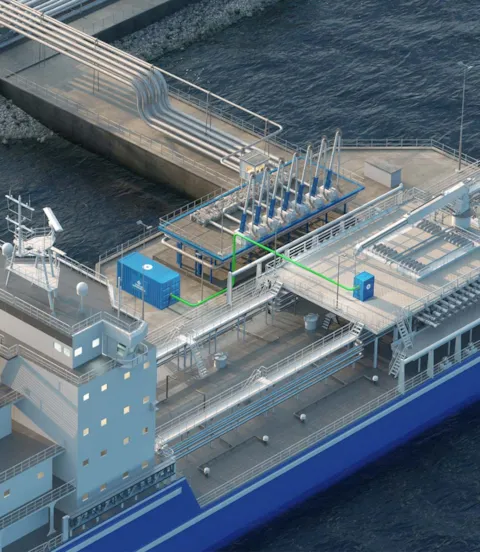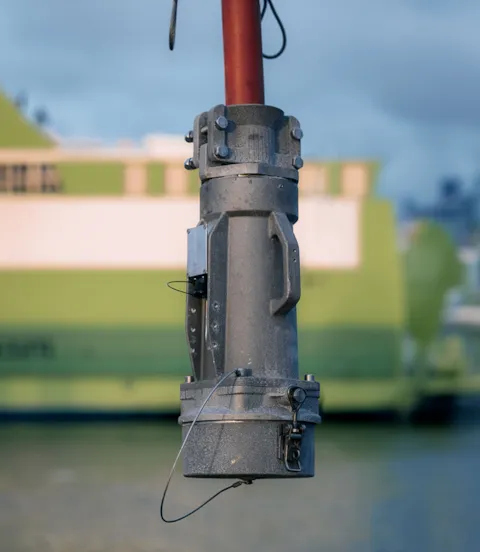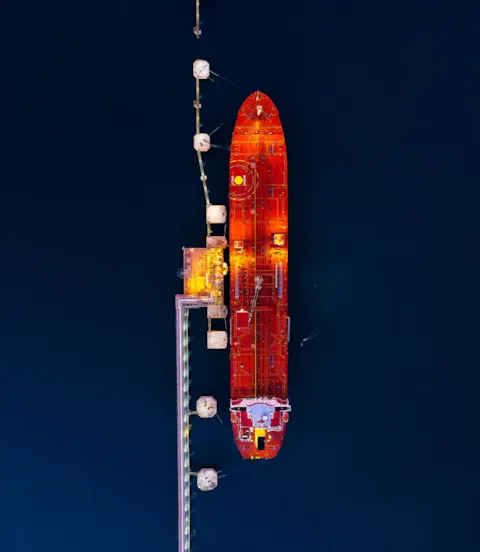A class notation for safe use of shore power
DNV’s updated Shore Power class notation for tankers provides crucial guidance for shipowners who wish to take advantage of shore power while lying at berth. The rules were developed in close cooperation with industry organizations to ensure practicability.
Ports and coastal states around the world have passed or are preparing legislation to curb air pollution from ships lying at berth, and to help cut carbon emissions in general. Using shore power is a great way for ships to keep their on-board systems running without emitting smoke and CO2. As the first rule set of its kind, DNV’s updated Shore Power class notation, effective as of 1 July 2023, addresses the specific safety needs of tankers.

International regulations and standards push shore power
Recent legislative advancements have prompted tanker owners to inquire about rules and standards for shore power for their ship type. The latest version of the California Air Resources Board’s (CARB) Ocean-Going Vessels At-Berth Regulation, published on 1 July 2023, requires tankers to have emission control strategies in place at specific Californian ports from January 2025. The EU has adopted similar legislation for container and passenger vessels, the ship types with the highest non-propulsion power demand, as part of the Fit for 55 package, including requirements for onshore power supply.

Hazardous cargo calls for special shore power rules
While the EU regulations do not apply to tankers, the unrivalled simplicity of plugging in a cable makes “cold ironing” an attractive option to meet emission control requirements during port stays of nearly any ship type. What has made the development of appropriate rules for tankers difficult is the type of cargo they carry. “At DNV, our primary focus is on safety. With tankers that often carry potentially flammable cargoes, the electrical risks can be greater than for dry bulk carriers and containerships. This requires more attention to system safety both on board and on the quayside,” explains Catrine Vestereng, Senior Vice President and Global Segment Director Tankers at DNV Maritime.

IEC standards provide a global basis
The crucial question is how and where to arrange the connecting points and cables safely, says Thomas Hartmann, Senior Principal Engineer – Electrical Systems Maritime at DNV, who is also a member of IEC Joint Working Group 28, Standardization of High-Voltage Shore Connection. “Class rules are often based on the relevant international standards,” he explains. “The relevant IEC standard calls for installation and testing of shore power equipment on board to be witnessed by an ‘appropriate authority’, which is typically the classification society that reviews the engineering designs for newbuilding and retrofitting projects. Ensuring a safe working environment for people on board tankers is a complex task.”

Complexities of shore power connection safety
Since ship types differ in terms of power demand, space restrictions and safety areas on board, they are addressed separately by both the IEC standard and the DNV Shore Power class notation. “Class rules must ensure safety without hampering ‘novel designs’ – the creative ideas the industry depends on to find new and better ways to build ships,” Hartmann points out. “In theory, the best and safest location for a shore power connection on board a tanker would be the aft section. But that is a challenge because of the way oil terminal jetties are normally designed. This is why we had to define rules allowing safe shore power connections midships – right in the hazardous area of a tanker where the cargo manifolds are located.”

Working with the industry to establish common ground
In response to the CARB regulatory changes, DNV, on behalf of the Western States Petroleum Association, performed a comprehensive gap analysis and identified a number of shortcomings in the regulatory landscape, including a lack of standardization for connection points, limited interface compatibility with terminal systems, and technology development constraints. “These gaps underscored the importance of establishing industry-standard guidelines to address safety concerns effectively and ensure the well-being of personnel and assets involved in tanker operations,” says Vestereng.

Collaborative efforts help DNV amend its Shore Power class notation rules
A joint industry working group, the Onshore Power Supply Work Group, was formed to develop guidance for standardized practices for the application of shore power for tankers, terminals and their interfaces. Initiated by the Oil Companies International Marine Forum’s (OCIMF) Environment Committee, it included Intertanko, the standards institutes, IACS representatives and DNV. This group and other stakeholders were part of the hearing conducted by DNV in March 2023 to ensure a comprehensive and inclusive process for our new rules.
“The updated DNV Shore Power class notation rules describe the requirements a power cable connecting point must meet to ensure a safe electrical connection and prevent explosion or other hazards, along with protection for the cable in case it must be routed across deck,” says Hartmann. For example, a “gas-safe area” can be created and maintained by applying forced-air ventilation, or as an alternative, by using nitrogen as a purging media, to the connecting point and installing a continuous monitoring system, explains the expert.

Shore power: A vital choice for tanker efficiency and compliance
“Owners are turning every stone to reduce their fuel consumption, and ultimately, their emissions. Shore power is therefore very interesting, especially for owners of ‘smaller’ tankers,” says Catrine Vestereng. Hartmann agrees: “Recent updates to international decarbonization regulations are placing greater emphasis on shore power.”
It makes sense to consider the shore power option from the newbuilding planning stages and make some preparatory arrangements for later retrofits, Hartmann continues, because retrofitting shore power equipment on tankers is usually tricky and costly. “In fact, DNV is considering offering a ‘shore-power-ready’ qualifier for ships prepared for conversion at a later time. We recommend that customers approach DNV for an informal meeting before beginning a newbuilding or conversion project to get the latest input from the industry on the development of shore power in the terminals. This can avoid unnecessary headaches at a later stage.”

Adapting to change: The evolving landscape of maritime standards and trends
Standards and class rules, propulsion and energy technologies are developing, and no-one can predict where these developments will ultimately lead. “Shipbuilders and shipowners are well advised to keep an eye on market and industry trends and follow the discussion,” says Hartmann. “Shore power is definitely a realistic option for complying with in-port emission restrictions and will play a major role.”
Thomas Hartmann
Senior Principal Engineer - Electrical Systems
- Gothenburg Port Authority
- san–i - stock.adobe.com
- Shutterstock / Jegor Glushenkov
- Shutterstock / UNIKYLUCKK